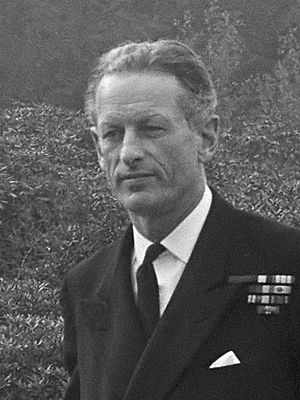William O'Brien (Royal Navy officer) facts for kids
Quick facts for kids
Sir William O'Brien
|
|
|---|---|

Admiral Sir William O'Brien in 1970
|
|
| Born | 13 November 1916 Faversham, Kent, England |
| Died | 19 February 2016 (aged 99) |
| Allegiance | United Kingdom |
| Service/ |
Royal Navy |
| Years of service | 1930–1971 |
| Rank | Admiral |
| Commands held | Western Fleet (1970–71) Far East Fleet (1967–69) Flag Officer, Aircraft Carriers (1966–67) HMS Hermes (1961–64) 8th Destroyer Squadron (1958–59) HMS Cheviot (1958–59) HMS Manxman (1955–57) HMS Venus (1948–49) HMS Cottesmore (1943–44) |
| Battles/wars | Second World War |
| Awards | Knight Commander of the Order of the Bath Distinguished Service Cross Mentioned in Despatches (2) |
Admiral Sir William Donough O'Brien was a very important officer in the Royal Navy, the United Kingdom's navy. He was born on November 13, 1916, and lived a long life, passing away on February 19, 2016, at the age of 99. He rose through the ranks to become an Admiral and even led a major part of the Navy called the Western Fleet.
Contents
Sir William started his journey in the Royal Navy in 1930. He studied at the Royal Naval College Dartmouth, a special school for future navy officers. After his training, he became an officer.
Serving in World War II
During the Second World War, Sir William played a role in protecting ships. He was part of the naval escort for a group of ships known as Convoy PQ 17. Convoys were groups of merchant ships traveling together with warships to protect them from enemy attacks.
In the early 1960s, Sir William worked at the Ministry of Defence. This is like the government department in charge of the country's military. He helped plan naval operations.
Later, he was given several big leadership jobs:
- In 1966, he became the Flag Officer, Aircraft Carriers. This meant he was in charge of the navy's aircraft carriers, which are huge ships that act like floating airfields.
- In 1967, he became the Commander-in-Chief, Far East Fleet. This put him in charge of all the Royal Navy ships and operations in the Far East.
- Finally, from 1970 to 1971, he was the Commander-in-Chief of the Western Fleet. This was a very high position, leading a large part of the Royal Navy.
Sir William retired from the Navy in 1971 after many years of service.
Even after retiring from the Navy, Sir William continued to be active. He became the Chairman of the King George's Fund for Sailors, an organization that helps people who work at sea and their families.
He also became the Chairman of the Kennet and Avon Canal. This is a historic waterway in England. He worked on its restoration, and when it was reopened by Queen Elizabeth II in 1990, he stepped down from his role.
Sir William also held honorary positions like Rear-Admiral and then Vice-Admiral of the United Kingdom. These are special titles given to respected navy figures. He passed away peacefully in 2016.
Family Life
In 1943, Sir William O'Brien married Rita Micallef. They had one son and two daughters together.

